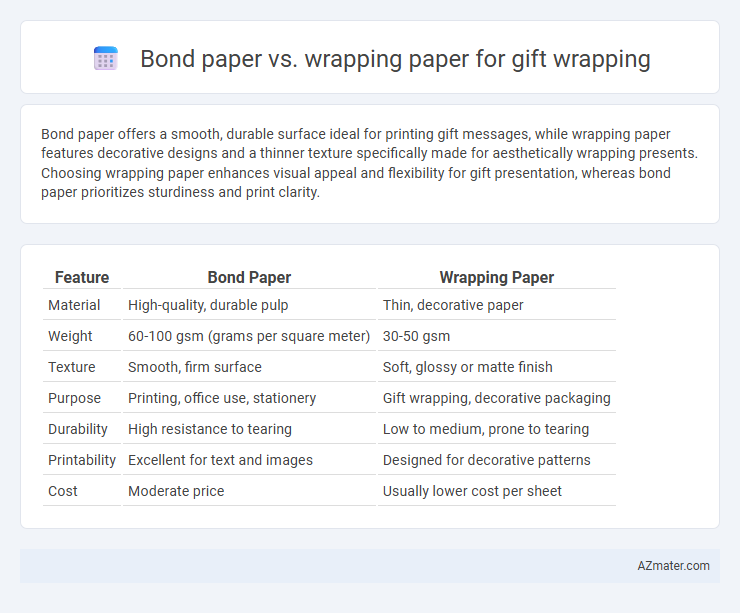Bond paper offers a smooth, durable surface ideal for printing gift messages, while wrapping paper features decorative designs and a thinner texture specifically made for aesthetically wrapping presents. Choosing wrapping paper enhances visual appeal and flexibility for gift presentation, whereas bond paper prioritizes sturdiness and print clarity.
Table of Comparison
| Feature | Bond Paper | Wrapping Paper |
|---|---|---|
| Material | High-quality, durable pulp | Thin, decorative paper |
| Weight | 60-100 gsm (grams per square meter) | 30-50 gsm |
| Texture | Smooth, firm surface | Soft, glossy or matte finish |
| Purpose | Printing, office use, stationery | Gift wrapping, decorative packaging |
| Durability | High resistance to tearing | Low to medium, prone to tearing |
| Printability | Excellent for text and images | Designed for decorative patterns |
| Cost | Moderate price | Usually lower cost per sheet |
Understanding Bond Paper and Wrapping Paper
Bond paper is a high-quality, durable material typically used for professional documents, featuring a smooth finish and excellent ink absorption, making it less ideal for decorative purposes. Wrapping paper, designed specifically for gift wrapping, offers a range of textures, colors, and patterns, prioritizing aesthetic appeal and flexibility to conform easily around various shapes. Selecting between bond paper and wrapping paper depends on the desired presentation, durability, and the visual impact needed for the gift.
Composition and Material Differences
Bond paper is typically made from wood pulp with a higher cotton content, providing durability, smoothness, and a professional finish, making it ideal for formal gift wrapping or printed designs. Wrapping paper is usually crafted from lightweight recycled fibers and features a thinner, more flexible texture designed specifically for easy folding and decorative purposes. The contrast in fiber content and thickness directly influences the rigidity and aesthetic qualities, distinguishing bond paper's sturdiness from wrapping paper's ornamental versatility.
Texture and Finish Comparison
Bond paper features a smooth, crisp texture with a matte or lightly glossy finish, ideal for writing or printing but less tactile for gift wrapping. Wrapping paper offers a variety of textures from smooth to embossed, often with a glossy or metallic finish that enhances visual appeal and tactile richness. The finish on wrapping paper is designed to reflect light and add decorative flair, whereas bond paper prioritizes functionality and readability.
Printability for Custom Gift Wrap
Bond paper offers excellent printability due to its smooth surface and high opacity, allowing for sharp, vibrant custom gift wrap designs with precise detail. Wrapping paper varies widely in texture and coating, which can affect ink absorption and print quality, making it less consistent for high-resolution prints. Choosing bond paper ensures professional-grade output and durability, ideal for personalized gift wrap projects requiring clear and crisp graphics.
Durability and Tear Resistance
Bond paper demonstrates superior durability and tear resistance compared to wrapping paper, making it ideal for heavy or awkwardly shaped gifts. Its tightly woven fibers and higher GSM (grams per square meter) contribute to enhanced strength and reduced risk of ripping during handling. Wrapping paper, often thinner and more decorative, is prone to tearing but offers flexibility and ease of folding for intricate gift presentations.
Aesthetic Appeal in Gift Presentation
Bond paper offers a smooth, clean finish that enhances the sharpness and clarity of printed designs, making it ideal for elegant, professional gift presentations. Wrapping paper typically features vibrant colors and patterns, providing a festive and decorative appeal that immediately draws attention and conveys celebration. Choosing between the two depends on whether the gift presentation aims for minimalist sophistication or eye-catching festivity.
Eco-Friendliness and Sustainability
Bond paper for gift wrapping offers higher eco-friendliness due to its recyclable and biodegradable properties, often made from sustainably sourced wood pulp with minimal chemical treatment. Wrapping paper, especially when glossy or laminated, tends to contain non-recyclable elements like plastic coatings or metallic finishes, reducing its sustainability and increasing landfill waste. Choosing bond paper minimizes environmental impact through easier recycling processes and lower resource consumption, supporting sustainable packaging practices in gift wrapping.
Cost Analysis: Bond vs Wrapping Paper
Bond paper generally costs more per sheet than wrapping paper due to its higher quality and durability, making it suitable for formal invitations or documents. Wrapping paper is more affordable and available in bulk, which reduces overall expenses for large-scale gift wrapping. Choosing between bond and wrapping paper depends on budget constraints and the desired presentation quality for gift packaging.
Versatility for Different Gift Types
Bond paper offers a smooth, sturdy texture ideal for wrapping books, electronics, and flat gifts, providing sharp folds and a professional appearance. Wrapping paper features a wide variety of patterns and finishes, making it perfect for diverse gift sizes and shapes, including irregular or bulky items. Both materials excel in versatility, but bond paper is preferred for a clean, minimalist look while wrapping paper is favored for decorative appeal.
Which Paper is Best for Your Gift-Wrapping Needs?
Bond paper offers a smooth, sturdy surface ideal for precise folds and professional-looking gift wraps, making it perfect for formal or corporate gifts. Wrapping paper is typically thinner, more flexible, and available in various decorative patterns, better suited for colorful, festive presentations but less durable. Choosing between bond and wrapping paper depends on the desired aesthetic and the need for durability or decorative appeal in your gift presentation.

Infographic: Bond paper vs Wrapping paper for Gift wrap
 azmater.com
azmater.com